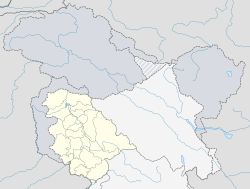Hemis National Park
|
Hemis National Park Hemis NP |
|
|---|---|
| National Park | |

Stok Kangri peak inside Hemis NP
|
|
| Location in Jammu and Kashmir, India | |
| Coordinates: 33°59′00″N 77°26′00″E / 33.98333°N 77.43333°ECoordinates: 33°59′00″N 77°26′00″E / 33.98333°N 77.43333°E | |
| Country |
|
| State | Jammu and Kashmir |
| District | Leh District |
| Established | 1981 |
| Area | |
| • Total | 4,400 km2 (1,700 sq mi) |
| Elevation | 3,000 - 6,000 m (−17,000 ft) |
| Languages | |
| • Official | Urdu |
| Time zone | IST (UTC+5:30) |
| Nearest city | Leh |
| IUCN category | II |
| Governing body | Government of India, Government of Jammu and Kashmir, |
| Precipitation | 160.5 millimetres (6.32 in) |
| Avg. summer temperature | 15 °C (59 °F) |
| Avg. winter temperature | −30 °C (−22 °F) |
Hemis National Park (or Hemis High Altitude National Park) is a high altitude national park in the eastern Ladakh region of the state of Jammu and Kashmir in India. World famous for being the best place to see the snow leopard in the wild, it is believed to have the highest density of snow leopards of any protected area in the world. It is the only national park in India north of the Himalayas, the largest notified protected area in India (and thus the largest national park of India), and is the second largest contiguous protected area after the Nanda Devi Biosphere Reserve and surrounding protected areas. The park is home to a number of species of endangered mammals including the snow leopard. Hemis National Park is India's only protected area inside the Palearctic ecozone, outside the Changthang Wildlife Sanctuary northeast of Hemis, and the proposed Tso Lhamo Cold Desert Conservation Area in North Sikkim.
The park is bounded on the north by the banks of the Indus River, and includes the catchments of Markha, Sumdah and Rumbak, and parts of the Zanskar Range.
The park was founded in 1981 by protecting the Rumbak and Markha catchments, an area of about 600 km2 (230 sq mi). It grew in 1988 to around 3,350 km2 (1,290 sq mi), by incorporating neighboring lands. It increased again in 1990 to 4,400 km2 (1,700 sq mi), and is the largest national park in South Asia.
The park houses numerous Tibetan gompas and holy chortens within its boundaries. These include the famous 400-year-old Hemis Monastery. Hemis was a destination and via point on the silk routes of Tibet. Over 1,600 people live inside the park presently, with a large number of tourists and pilgrims visiting during the Hemis Tsechu festival.
...
Wikipedia


